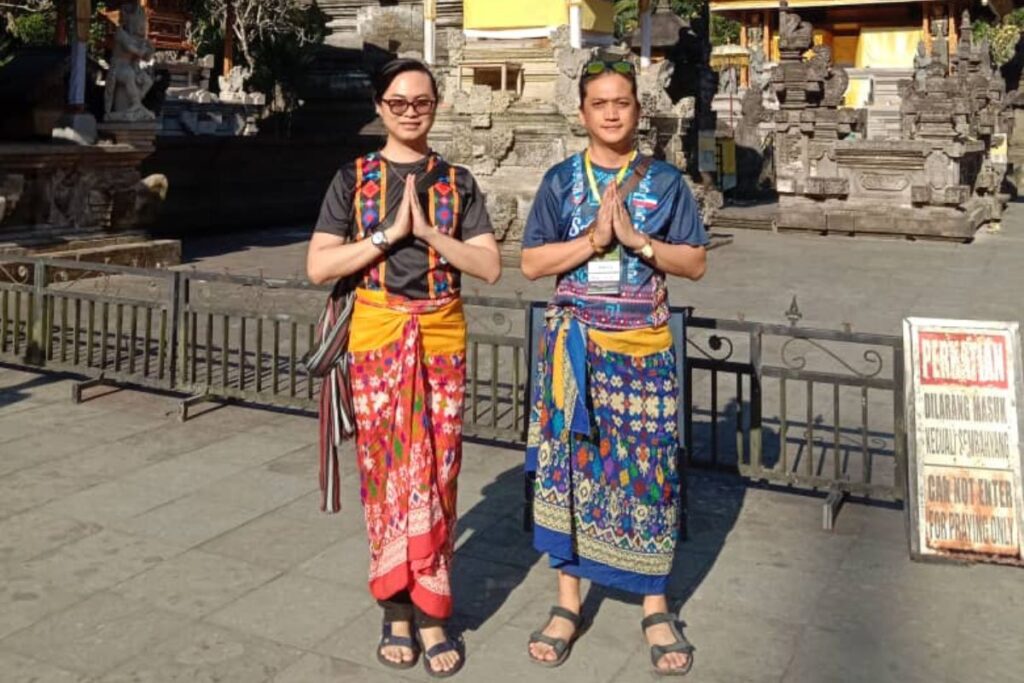Young people I met in Bali
Although the coronavirus pandemic seems to be over, airfares are still skyrocketing, and furthermore, due to funding issues, a decision has not been made on whether or not to hold the ALL Forum’s pan-Asian program for youth or AYA/ATF this year even just a few months before the scheduled program. Problems arose one after another, making us anxious many times, but ‘nevertheless,’ we finally made the final decision to hold the forum in Bali, Indonesia. When I landed at Bali Airport, traces of the terrifying coronavirus infection that was said to have never been experienced before by mankind could only be seen on the taxi driver’s mask. No matter where I went during the 10 days of the youth workshop, Bali was overflowing with foreigners from America and Europe. Even when I arrived at the workshop venue after driving for a good hour, I couldn’t actually see the famous sea or beach of Bali, but instead, they were clearly visible. After the pandemic, the voices that were shouting about ‘new civilization’ and ‘new normal’ seemed to have been sucked into the wave of Americans and Europeans without a trace, so I felt somewhat vain or complicated feelings that were difficult to express in words.

Fortunately, however, thanks to the busyness of preparing and running the program and the young people who participated in the event, I could sense that my heavy feelings quickly disappeared. Antony, a male activist working for women’s rights on the Indonesian island of Sumba, was a young man with an extraordinary background. In particular, he attracted great interest from many other young people when he brought up problems such as ‘early marriage’, ‘forced marriage’, and ‘bride kidnapping’, which have been worsened on Sumba Island during the Corona period. Meanwhile, Alin, who is from Bali, explains why the religions here seem to be mixed and complicated, and wherever you go in this region, even the stone statues in front of the gate or the small food served in front of the door have a religious and cultural meaning that cannot be ignored. In addition, Mags, who is from Mindanao Island in the Philippines and has attended ALL Forum’s programs several times, said that she was so desperate for the education of tribal youth that she decided to devote herself to being an ‘educational activist’ rather than a regular teacher as her longtime dream before, which got a big applause from the other young participants. Nevertheless, among them, the ones that were most impressive and resonated the most were Adam and Maveric, who participated from Sabah, Malaysia. They identify themselves as ‘protector of Indigenous People’s religious and cultural traditions’. And they belong to a tribe called Kadazan, but both of them are deeply religious Catholics at the same time.
“I became a shaman because of my faith in God.”
When conducting programs for youth in Southeast Asia, it is difficult not to include young people from indigenous communities. This is also because indigenous communities often work together as co-organizers of our programs. Moreover, if the topic is related to the ecological crisis or climate change, as in this case, their existence is even more highlighted. In terms of region, it can be said to cover almost all of Southeast Asia, including the Philippines and the countries of the Indochina Peninsula, as well as Indonesia and Malaysia. In countries like Korea, where there is no concept of indigenous people, even if you explain it, it is easy to hear it with one ear and ignore it with the other, saying, ‘I guess so.’ It’s not because I’m not interested, but because it doesn’t touch my skin. For example, in Indonesia alone, there are some 250 tribes and over 300 languages, and if there are so many people living such diverse lives, it would be difficult to even count them. When conducting youth workshops in Mindanao Island in the Philippines or Chiang Mai, Thailand, it is common for indigenous Catholic priests to wear tribal clothes and participate in various programs, including liturgies. It may sometimes be a source of surprise and shock to Korean Religious and clergy who are mainly accustomed to black and white gray nuns’ uniforms and ‘Roman color’ for the priests.
Anyway, Adam and Maverick were unique in many ways. In particular, Adam, who was born and raised in a Catholic family for generations, said that just as Catholic priests became priests due to God’s calling, he also “became a shaman because of his Catholic faith and in response to God’s calling.” As a priest or spirit medium of an indigenous religion, the reason he became a shaman was because of his faith in God. It may be too much for ordinary Catholics to swallow and digest it with no difficulty. Rather, it may be not trustworthy to believe in directly or resisted from inside in them. However, there is no other way to explain why Adam, like Maverick, willingly jumped into the difficult life of protecting the religious and cultural traditions of his tribe without any financial compensation, other than looking at God’s call and his firm faith. If there is anything different from the expectations or common sense of believers, it is only unusual that God’s call chose a priest of an indigenous traditional religion rather than a Catholic priest. Moreover, in this tribe, women traditionally become shamans called Bobohizan, whereas he is neither a woman nor a man in the conventional sense, but is a sexual minority with a ‘third gender’ that cannot be divided into such dual genders. Nevertheless, he takes on the role of Bobohizan and is faithfully trying to preserve the traditions of the tribesmen with those who share the same ideas as him. I simply can’t imagine what kind of difficulties they have gone through up until so far. That is the moment of realization making me feel strong empathy with them.

Maverick says that no one in the area where he lives is willing to do the work of protecting religious and cultural traditions, and smiles kindly, saying, “Shouldn’t young people like us step forward to awaken them?” Around 2020, thanks to their devotion and determination, they took the lead in creating an association for protecting traditional religion and cultures in Sabah and achieved the ‘splendid achievement’ of signing about 30 members, including Bobohizans. In the background, there are men like Maverick and Adam, especially the former who is a father of two children and is struggling to make ends meet as he does not receive any financial support from the Sabah State government or the church. Nonetheless, he is following God’s path without being shallow “sentimentality” or mumbo jumbo. Isn’t this the spirit and attitude of life that is difficult to dream of in Korea’s reality, where ‘even if three poets gather together, they also talk about apartment prices’?
The Kadazan tribe is an indigenous community with such a long history that it has been recognised by UNESCO. They are the most populous of the region’s indigenous tribes, and the majority of Catholic church members in the region. Their expectations from the church are simple. First of all, do not denounce or openly criticize the religious traditions of the indigenous people as superstitions, and do not insult Bobohizans with groundless claims that they are devil worshipers. Maverick asserts that he is a Catholic from birth and was born into the Kadazan tribe at the same time, so the two cannot be separated, and neither side can be removed or erased from him. ‘Synodality’? This is a very unfamiliar word to them. The unfamiliarity stems not from the difficult meaning of the word itself, but from the negative relationship between the local church and its history of demonizing indigenous communities. They reiterate what has been said before on this topic: that the Church should, above all, respect the traditional religions of tribal peoples and adopt an attitude of recognition and acceptance for their active role in parishes and dioceses. Indeed, without this premise, what kind of synodality would possibly meant to them? Emerging church does not need to be a new church, rather it is renewed and reformed from within by embracing and reviving the people’s religio-cultural traditions in Asia.
Asian Christianity as Emerging Church for the Future
Once a Korean poet said, “I think humans alone are plants.” Even if it has a strong message, it should not be that surprising to us Catholics. This is because, in Laudato Si’, we have already declared a revolution that overturns the entire 2,000-year-old Christian worldview that “humans are nature” (no. 139), and through the Amazon Synod, we have the final document of the Synod and ‘Beloved Amazon’. This is because the documents have given birth to a new baby called ‘interculturation’, where the church and local culture meet as equals. One more thing: Nine countries in the Amazon region gathered to establish the ‘Ecclesial Conference of the Amazon (ECA)’, and a few months later, in October 2022, Pope Francis officially approved it. Although it began as an organization of bishops, it must develop into an organization that will represent the whole People of God. To this end, as a specific plan for ‘Synodal Formation’ raised at this youth workshop, first of all, an organization and program to reform the structure in which bishops govern like kings and train them on how to integrate them into the ‘collegiality of the whole People Of God’. Integration of bishops is required. In addition, the complete reform of the current seminary curriculum to qualify as priests and pastors required by the 21st century, as well as the most important and essential, establishment of institutions and financial investment for training lay leaders and young people, must be given priority.

The very basic premise for this is church finances clearly reported for the whole Catholics in Asia. In particular, the finances of each diocese must be revealed in detail and the bold investments made for this ‘Synodal Formation’ must be transparently shown in numbers. Only by quickly establishing a system to train dedicated and courageous young leaders like Adam and Maverick will we be able to get a glimpse of the possibility of Christianity, especially Asian Christianity as emerging church , surviving in Asia.*
By: Dr. Paul Hwang / Director ALL Forum

